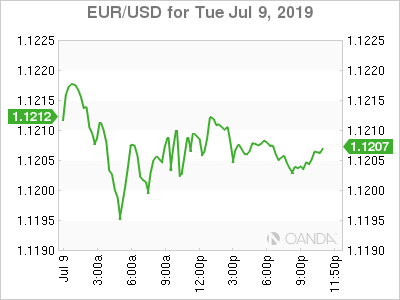The Canadian dollar is lower against the US dollar on Tuesday. The narrative of multiple rate cuts by the Fed was put into question on Friday with a massive rebound in the American job report for June. The number of jobs was higher than expected and is raising concerns that three rate cuts might be too much.
In true monetary policy maker fashion Fed Chair Powell did not say much to guide markets during his address at the Boston Fed. The highlight of the week will be his two-day testimonies in front of congress and the senate. Sandwiched between the two will be the release of the minutes from the FOMC in June.
The Bank of Canada (BoC) will release its rate statement on Wednesday at 10:00 am, but the market anticipates the central bank keeping rates intact at 1.75 percent. Governor Poloz will host a president conference at 10:15 am, where he is expected to continue with the dovish rhetoric that has become common place with major central banks. The BoC is not facing the same pressures as the Fed to lower interest rates, but trade headwinds have not shown signs of dissipating, which will give Poloz plenty to discuss during his press conference.
The US dollar is higher across the board on Tuesday head of Fed Chair Powell’s testimony before congress and the release of the minutes from the June FOMC, where the central bank held rates unchanged, but did signal an impending interest rate cut.
A massive job gain in June is making the market second-guess the number of possible rate cuts this year by the Fed. A strong rebound from a disappointing May report showed a 224,000 gain in June and boosted the US dollar against major pairs.
The dollar had been under pressure from rising interest rate cut probabilities but also the fact that the White House was ready to open another trade war front, this time with Europe. US-China talks at the G20 did not provide any new details, but a new round of talks is expected. Tariffs against the EU diverted safe haven flows away from the US dollar and into other options like the Swiss franc, the Japanese yen and gold.
OIL – Crude Rises on Middle East Tension and Lower API Inventories
West Texas Intermediate and Brent both saw gains on Tuesday. Crude traders remain on the lookout for guidance and tomorrow will bring plenty of news and data to chew on. The rebound of the dollar has had limited effect on energy prices, but if Fed Powell does not keep singing to a dovish tune in his testimony before congress, the rebound could turn into a rally.
Crude inventories in the US will be published on Wednesday at 10:30 am. The rise of US production has been a major factor to the decline in crude prices, and only the concerted effort of the OPEC+ and geopolitical supply disruptions have been able to offset it temporarily.
The tensions in the Middle East could escalate into an energy supply nightmare if the Strait of Hormuz is closed or the traffic from tankers severely disrupted.
The API crude stockpiles published on Tuesday afternoon fell more than forecasted with an 8.1-million-barrel drawdown and traders will await the official Energy Information Administration (EIA) weekly crude data for direction on energy prices.
GOLD – Gold Regains some Traction Awaits Fed Chair Testimony and FOMC Minutes
Gold is close to positive territory on Wednesday after touching weekly lows. The yellow metal stumbled as the greenback got its mojo back after a strong jobs report published on Friday. Gold is within sight of the $1,400 price level awaiting the testimonies of Fed Chair Powell and the release of the FOMC minutes form the June meeting.
Gold was boosted as investors bought back into long gold positions as the metal is once again a top safe haven during periods of high uncertainty. Rising tensions in the Middle East, ongoing trade wars and another UK Prime Minister to reopen Brexit have created demand for gold.
The Fed is expected to keep the dovish rhetoric in place, not confirming or denying how many rate cuts or when they will happen, but by mere mention of lower interest rates it validates the market’s expectations of a rate cut sooner rather than later. Lower rates will act in favour of the metal, and if the minutes give the same impression gold could break above $1,400 once more.
USD/MXN Mexican Peso Drops After Finance Minister Resigns
The Mexican peso fell more than 1.6 percent on Tuesday after the surprise announcement by the Finance Minister Carlos Urzua after a year in office. The currency dropped immediately given the reasons cited by the former minister for tendering his resignation, political decisions that lacked support from economic fundamentals.
President Lopez Obrador announced Urzua’s successor by promoting from within the Finance Ministry Arturo Herrera Gutierrez.
The MXN broke above the 19-peso price level and even after the new appointment still trades at 19.15. Investors will be monitoring the situation, with an eye on what Urzua’s resignation means for the financing of large projects that have been promised by the Mexican president.
The Fed is gearing up for its first rate cut to start a new monetary easing cycle, after the White House has been piling on pressure to lower rates despite economic indicators not raising massive red flags. The peso has been trading higher on dollar softness, but now political issues have put the Mexican currency on the back foot.


















